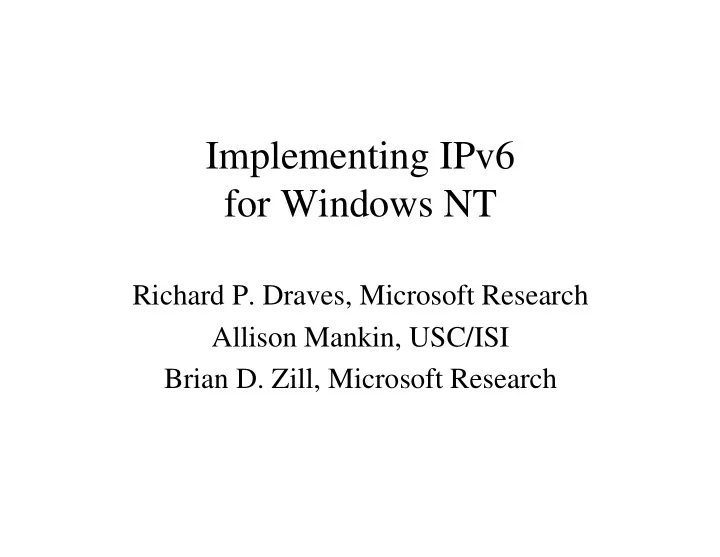

Implementing IPv6 for Windows NT Richard P. Draves, Microsoft Research Allison Mankin, USC/ISI Brian D. Zill, Microsoft Research
Main Points • Windows NT is a good base for network protocol development • Our release is great sample code: http://research.microsoft.com/msripv6
Outline • Motivation • Windows NT Networking • Our Implementation • Problems & Solutions • Source Code Access • Performance • Conclusions
Motivation • Primarily a learning experience • Bootstrap Microsoft on IPv6 • Platform for further research
Windows NT Networking Application Existing Components User Process Winsock Added Components ws2_32.dll NSP Winsock 2 WSP WSH wship6.dll msafd.dll rnr20.dll Winsock Helper for IPv6 MS’s Winsock Provider MS’s Namespace Provider afd.sys Kernel Driver for Winsock TDI tcpip6.sys IPv6 Protocol NDIS NDIS dc21x4.sys ndis.sys Device-Specific Driver Device-Independent Driver
Our Implementation • Started with NT 4.0 TCP/IP source code • Supports only IPv6 • Supports only NT 4.0/5.0
Our Implementation Upper-Layer TCP UDP Protocols ICMP MLD Core Neighbor Send/Receive Routing Discovery Link-Layer Modules LAN Loopback Tunnel
Problems & Solutions • NDIS receive handlers • Adding link-layer headers • “Pull-up” non-contiguous packet data • Preventing deadlock with NDIS and TDI
NDIS Receive Handlers • Asynchronous callbacks • ProtocolReceive – flat look-ahead buffer – may need separate call to transfer data • ProtocolReceivePacket – NDIS_PACKET structure with buffer chain – not implemented by all NICs – miniport owns the packet/buffers
NIC Implementations • ProtocolReceive + transfer data – Intel EtherExpress 16 • ProtocolReceive – SMS EtherPower II – 3com Fast Etherlink XL – Intel EtherExpress PRO • ProtocolReceivePacket – Digital DE435
Our NDIS Receive Handler • Link-layer module hides complexity – Pass up our own IPv6_PACKET structure • Supports both receive handlers – IPv4 code only supported ProtocolReceive • Does transfer-data internally if needed – May introduce a copy relative to IPv4
Adding Link-Layer Headers • Must construct link-layer header before handing packet to NDIS • NT 4.0 IPv4 code chains a buffer in the link-layer module – Adds complexity – Reduces performance • Allocate space up front – But how much space? – NDIS does not support a packet offset
Our Solution • Leave room for worse-case link-level header • Rewrite NDIS packet to hide unused space – Must undo this after the send completes – Communicate offset value in the context area – What if the unused space spans two pages?
Source Code Access • Source for Windows NT 4.0 TCP/IP – Sample code, UDP/TCP, TDI glue – Replaced all link-layer, IP, ICMP, MLD code – DDK sample code • Source for other Windows NT components – Not essential – Useful for debugging & documentation – Our only modification was a fix in msafd.dll
Performance TCP Throughput in KB/s 10 Mb/s 100 Mb/s IPv4 1058±4 10995±20 IPv6 1032±3 10790±30 • Expected 1.4% slower, saw 2.5% / 1.9% • 300Mhz P-II -> 266Mhz, SMC Etherpower II
Conclusions • Windows NT is a good base for network protocol development • Our release is great sample code: http://research.microsoft.com/msripv6 – Testing, research, educational uses
Recommend
More recommend